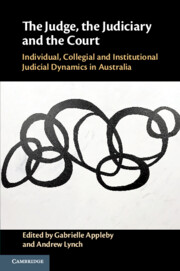 The Judge, the Judiciary and the Court
The Judge, the Judiciary and the Court Book contents
- The Judge, the Judiciary and the Court
- The Judge, the Judiciary and the Court
- Copyright page
- Contents
- Figures
- Tables
- Contributors
- Foreword
- Cases
- Part I The Judge, the Judiciary and the Court
- Part II Debates and Challenges to the Judicial Role
- 4 Dismantling the Diversity Deficit
- 5 Technology and the Judicial Role
- 6 Emotion Work as Judicial Work
- 7 The Persistent Pejorative
- Part III The Judiciary as a Collective
- Part IV Perceptions
- Index
7 - The Persistent Pejorative
Judicial Activism
from Part II - Debates and Challenges to the Judicial Role
Published online by Cambridge University Press: 04 May 2021
- The Judge, the Judiciary and the Court
- The Judge, the Judiciary and the Court
- Copyright page
- Contents
- Figures
- Tables
- Contributors
- Foreword
- Cases
- Part I The Judge, the Judiciary and the Court
- Part II Debates and Challenges to the Judicial Role
- 4 Dismantling the Diversity Deficit
- 5 Technology and the Judicial Role
- 6 Emotion Work as Judicial Work
- 7 The Persistent Pejorative
- Part III The Judiciary as a Collective
- Part IV Perceptions
- Index
Summary
Perhaps one of the most enduring legal controversies in recent decades, at least in the public sphere, relates to the acceptability of ‘judicial activism’ as a practice on the bench. Activism, of course, has no fixed definition; nor is it a term that has been adopted with any great zeal by Australian practitioners or the academy. But there is no doubt that the early, benign (if simplistic) understanding of activism as a binary opposite to judicial restraint has been overshadowed by a particularly rancorous public debate about the supposedly growing numbers of progressive activists radically departing not from mere restraint but from judicial ‘orthodoxy’.
This chapter provides an up-to-date survey of the usages of the activist label in Australia, and contends that the rubric of activism obstructs, rather than buttresses, a sophisticated and robust critique of judicial decision-making. The increasing difficulty in untangling the language of activism from public understandings of judicial work is acknowledged, given that the nature of debate on the role of the judiciary has markedly changed in Australian political discourse over the last three decades. The chapter examines the reasons for the persistence of the unhelpful term, and examines the potential for the judiciary and wider legal community to push for public discourse to move beyond activism as a means of analysis.
- Type
- Chapter
- Information
- The Judge, the Judiciary and the CourtIndividual, Collegial and Institutional Judicial Dynamics in Australia, pp. 163 - 186Publisher: Cambridge University PressPrint publication year: 2021


